Trello Best Practices for Project Management
Digital Marketing
Introduction to Trello
Trello is a popular project management tool that offers a visual and flexible way to organize and manage tasks. It uses boards, lists, and cards to help teams collaborate and stay organized.
Benefits of Using Trello for Project Management
When it comes to project management, utilizing Trello boards can enhance efficiency and streamline collaboration within teams. Some key benefits include:
- Visual project organization
- Customizable workflows
- Improved task prioritization
- Enhanced team communication
Top Trello Best Practices
1. Create Detailed Boards
Start by creating Trello boards that adequately represent your project structure. Each board should focus on a specific aspect of the project, such as tasks, timelines, or team responsibilities.
2. Organize Tasks with Lists and Cards
Utilize Trello lists and cards to break down tasks into manageable units. Assign due dates, labels, and attachments to cards for better organization and tracking.
3. Incorporate Planning Poker
Implement planning poker in your project management process to estimate the effort and complexity of tasks more accurately. This collaborative technique ensures team alignment on task priorities.
4. Collaborate Effectively
Encourage team collaboration by using Trello cards for assigning tasks, leaving comments, and sharing progress updates. Leverage the power of integrations with tools like Slack for seamless communication.
5. Regularly Review and Update
Keep your Trello boards up to date by regularly reviewing and updating tasks, deadlines, and project statuses. Conduct team meetings to discuss progress and identify any bottlenecks.
Conclusion
By following these Trello best practices for project management, you can optimize your workflow, improve team collaboration, and achieve project success. Implement these strategies to elevate your project management efficiency with Trello.
Tridap Media - Business and Consumer Services - Digital Marketing









